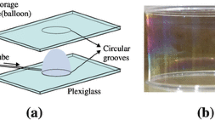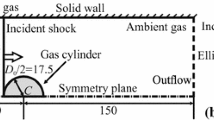Abstract
Interactions of shock waves and heavy gas cylinders with different diffusive interfaces are numerically investigated. Comparisons among these interfaces are made in terms of cylinder morphology, wave system evolution, fluid mixing, and circulation generation. Navier–Stokes equations are solved in the present work to simulate the complex multi-fluid flow. A fifth-order weighted essentially non-oscillatory scheme is used to compute the numerical flux. The influence of interface diffusion is revealed by numerical results. Cylinders with similar geometric scale but different diffusion interface have significant similarities in hydrodynamic characteristics, including the interface morphology, shock focusing, and molecular mixing, as well as circulation deposition. For cases with more severe interface diffusion, the cylinder develops into more regular vortex pairs. The diffusive interface significantly mitigates the strength of the reflected shock wave and weakens the shock focusing capability. Some interface evolution features are also recorded and analyzed. The diffusive interface brings about slower molecular mixing and less circulation generation. The circulation deposition on different interfaces is quantitatively investigated and compared with the theoretical models. The theoretical models are found to be applicable to the scenarios of diffusive interfaces.















Similar content being viewed by others
References
Ranjan, D., Oakley, J., Bonazza, R.: Shock–bubble interactions. Annu. Rev. Fluid Mech. 43, 117–140 (2011)
Arnett, W.D., Bahcall, J.N., Kirshner, R.P., et al.: Supernova 1987A. Ann. Rev. Astron. Astrophys. 27, 629–700 (1989)
Lindl, J.D., Mccrory, R.L., Campbell, E.M.: Progress toward ignition and burn propagation in inertial confinement fusion. Phys. Today 45, 32–40 (1992)
Yang, J., Kubota, T., Zukoski, E.E.: Applications of shock-induced mixing to supersonic combustion. AIAA J. 31, 854–862 (2012)
Richtmyer, R.D.: Taylor instability in shock acceleration of compressible fluids. Commun. Pure Appl. Math. 3, 297–319 (1960)
Meshkov, E.E.: Instability of the interface of two gases accelerated by a shock wave. Fluid Dyn. 4, 101–104 (1969)
Rudinger, G., Somers, L.M.: Behaviour of small regions of different gases carried in accelerated gas flows. J. Fluid Mech. 7, 161–176 (1960)
Haas, J.F., Sturtevan, B.: Interaction of weak shock waves with cylindrical and spherical gas inhomogeneities. J. Fluid Mech. 181, 41–76 (1987)
Capuano, M., Bogey, C., Spelt, P.D.M.: Simulations of viscous and compressible gas–gas flows using high-order finite difference schemes. J. Comput. Phys. 361, 56–81 (2018)
Picone, J.M., Boris, J.P.: Vorticity generation by shock propagation through bubbles in a gas. J. Fluid Mech. 189, 23–51 (1988)
Haimovich, O., Frankel, S.H.: Numerical simulations of compressible multicomponent and multiphase flow using a high-order targeted ENO (TENO) finite-volume method. Comput. Fluids 146, 105–116 (2017)
Yoo, Y.L., Sung, H.G.: Numerical investigation of an interaction between shock waves and bubble in a compressible multiphase flow using a diffuse interface method. Int. J. Heat Mass Transf. 127, 210–221 (2018)
Layes, G., Jourdan, G., Houas, L.: Distortion of a spherical gaseous interface accelerated by a plane shock wave. Phys. Rev. Lett. 91, 174502 (2003)
Giordano, J., Burtschell, Y.: Richtmyer–Meshkov instability induced by shock–bubble interaction: numerical and analytical studies with experimental validation. Phys. Fluids 18, 036102 (2006)
Zhu, Y., Yang, Z., Pan, Z., et al.: Numerical investigation of shock-SF6 bubble interaction with different mach numbers. Comput. Fluids 177, 78–86 (2018)
Zeng, W., Pan, J., Ren, Y., et al.: Numerical study on the turbulent mixing of planar shock-accelerated triangular heavy gases interface. Acta Mech. Sin. 34, 855–870 (2018)
Si, T., Zhai, Z., Luo, X.: Interaction of strong converging shock wave with SF6 gas bubble. Sci. China Phys. Mech. 61, 064711 (2018)
Ou, J., Ding, J., Luo, X., et al.: Effects of Atwood number on shock focusing in shock–cylinder interaction. Exp. Fluids 59, 29 (2018)
Zhai, Z., Si, T., Zou, L., et al.: Jet formation in shock-heavy gas bubble interaction. Acta Mech. Sin. 29, 24–35 (2013)
Jacobs, J.W.: Shock-induced mixing of a light-gas cylinder. J. Fluid Mech. 234, 629–649 (1992)
Tomkins, C., Kumar, S., Orlicz, G., et al.: An experimental investigation of mixing mechanisms in shock-accelerated flow. J. Fluid Mech. 611, 131–150 (2008)
Shankar, S.K., Kawai, S., Lele, S.K.: Two-dimensional viscous flow simulation of a shock accelerated heavy gas cylinder. Phys. Fluids 23, 024102 (2011)
Zou, L., Liao, S., Liu, C., et al.: Aspect ratio effect on shock-accelerated elliptic gas cylinders. Phys. Fluids 28, 297–319 (2016)
Yang, J., Kubota, T., Zukoski, E.E.: Model for characterization of a vortex pair formed by shock passage over a light-gas inhomogeneity. J. Fluid Mech. 258, 217–244 (1994)
Samtaney, R., Zabusky, N.J.: Circulation deposition on shock-accelerated planar and curved density-stratified interfaces: models and scaling laws. J. Fluid Mech. 269, 45–78 (1994)
Gupta, S., Zhang, S., Zabusky, N.J.: Shock interaction with a heavy gas cylinder: emergence of vortex, bilayers and vortex-accelerated baroclinic circulation generation. Laser Part. Beams 21, 443–448 (2003)
Strang, G.: On the construction and comparison of difference schemes. SIAM J. Numer. Anal. 5, 506–517 (1968)
Ruuth, S.J.: A new class of optimal high-order strong-stability-preserving time discretization methods. SIAM J. Numer. Anal. 40, 469–491 (2003)
Gottlieb, S., Shu, C.W.: Total variation diminishing Runge–Kutta schemes. Math. Comput. 67, 73–85 (1998)
Verwer, J.G., Sommeijer, B.P., Hundsdorfer, W.: RKC time-stepping for advection–diffusion–reaction problems. J. Comput. Phys. 201, 61–79 (2004)
Niederhaus, J.H.J., Greenough, J.A., Oakley, J.G., et al.: A computational parameter study for the three-dimensional shock–bubble interaction. J. Fluid Mech. 594, 85–124 (2008)
Author information
Authors and Affiliations
Corresponding author
Rights and permissions
About this article
Cite this article
Li, D., Guan, B. & Wang, G. Numerical study on shock-accelerated heavy gas cylinders with diffusive interfaces. Acta Mech. Sin. 35, 750–762 (2019). https://doi.org/10.1007/s10409-019-00867-w
Received:
Revised:
Accepted:
Published:
Issue Date:
DOI: https://doi.org/10.1007/s10409-019-00867-w




